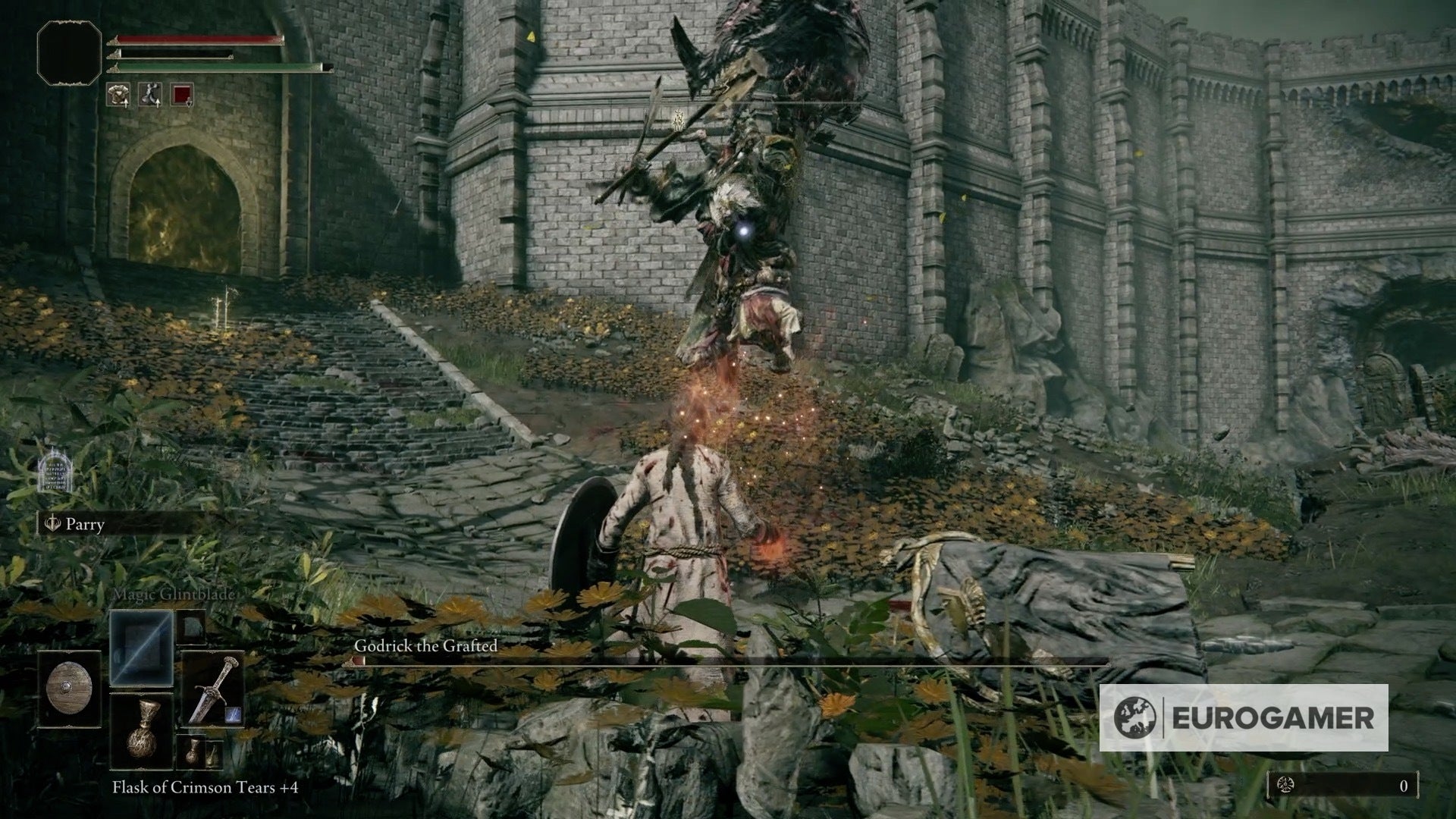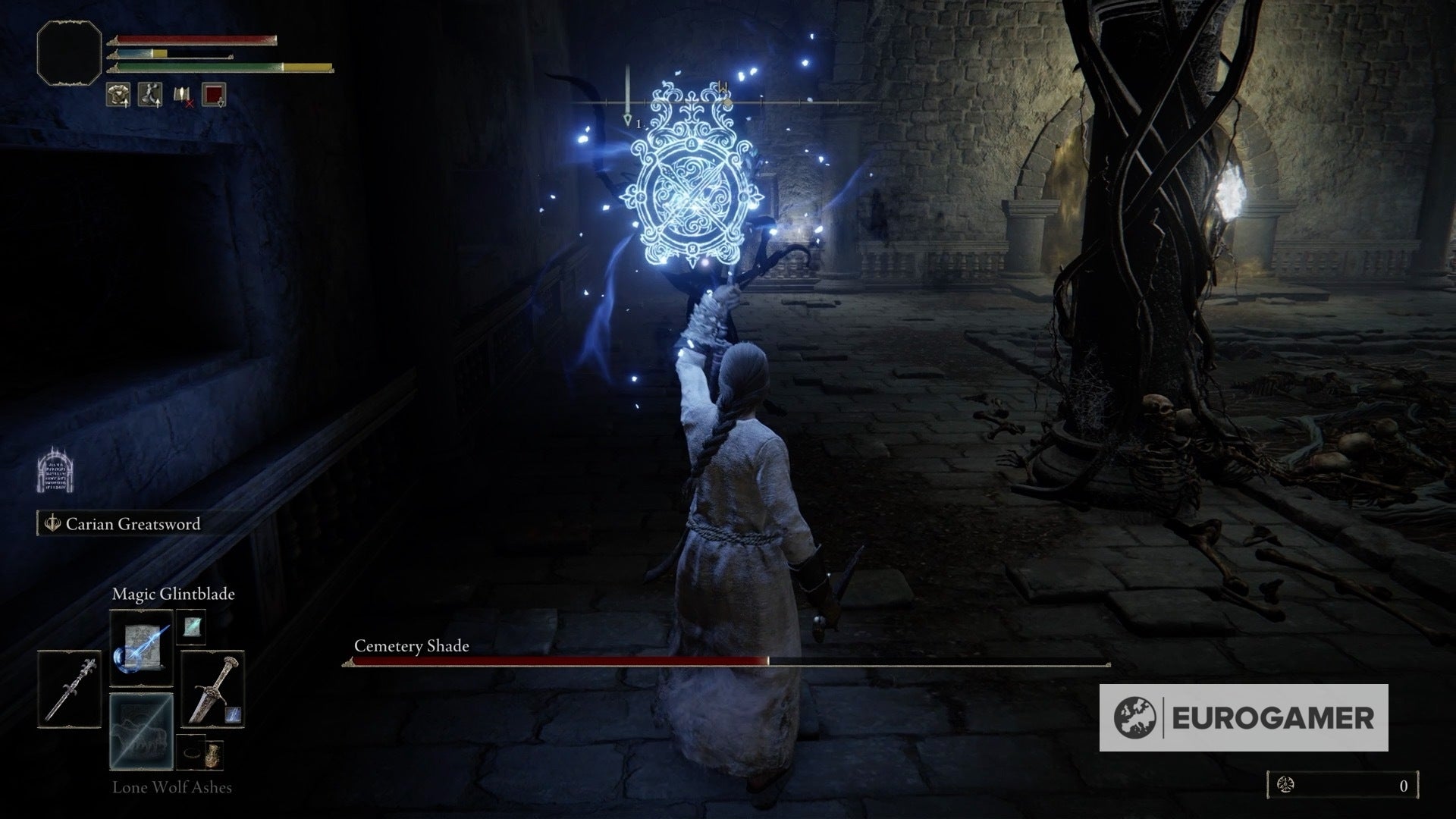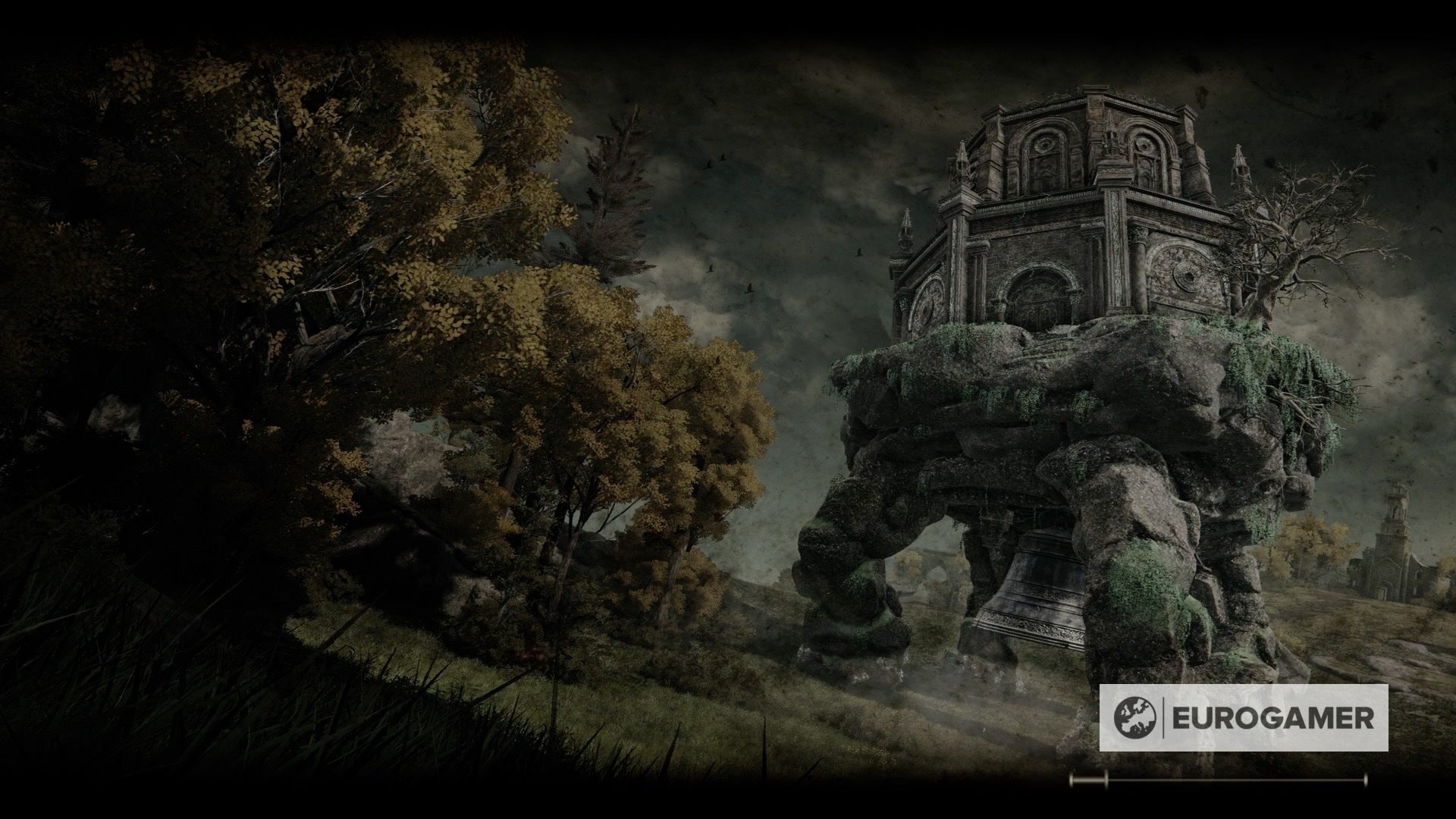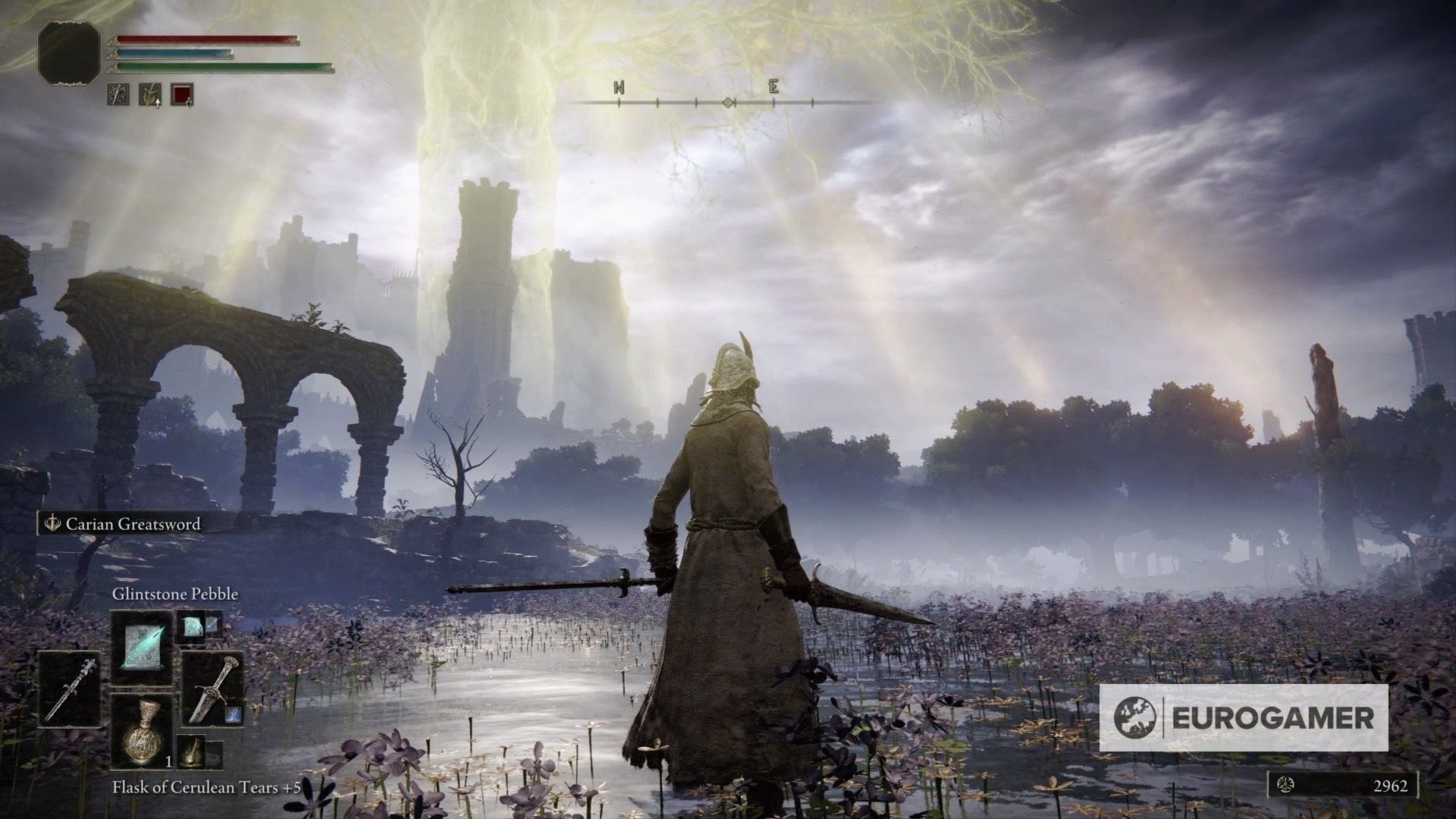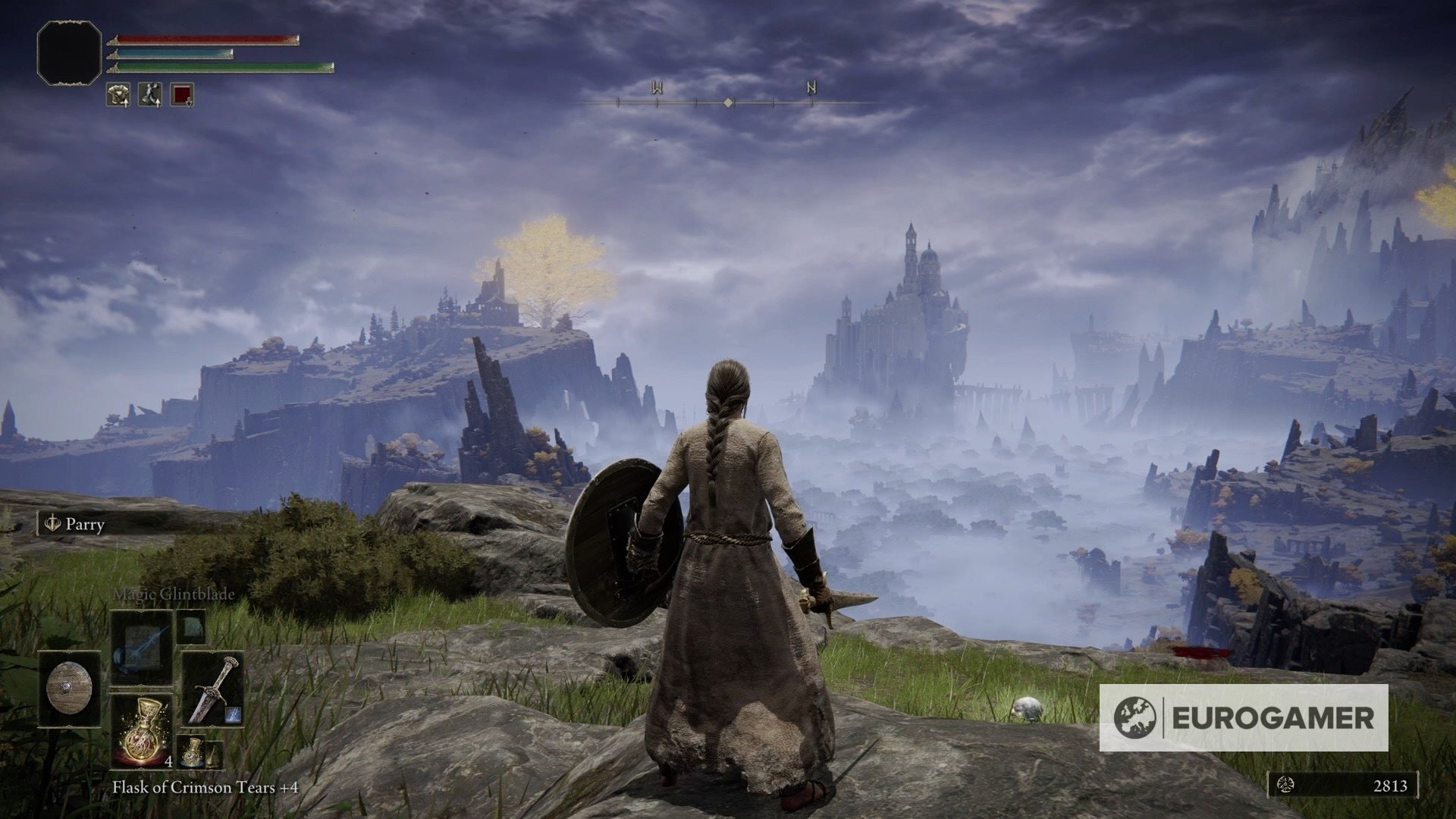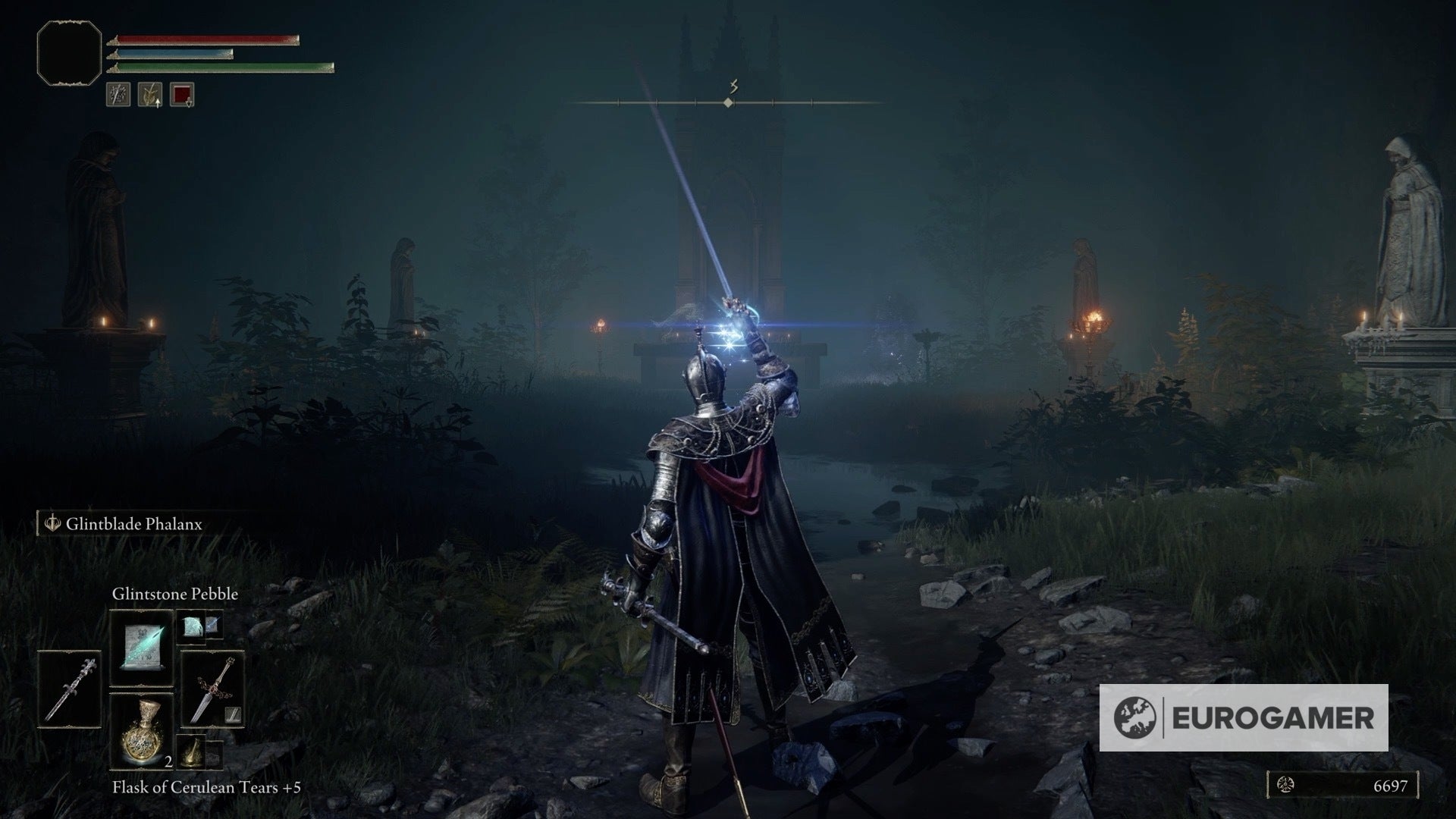Every dank, echoing cave you step into could spell your doom, every seemingly sleepy ruin or settlement you pick your way through could be harbouring any number of twisted inhabitants seeking your cold, lonely end. Even out under the vast, open skies of these Lands Between you aren’t safe. Your trusty steed Torrent might speed you from certain dangers, true, but even he isn’t fleet-footed enough to outrun a tornado of dragonfire or a billowing cloud of poison spewed forth by a corrupted sentient flower. In this world, you start as nothing, no-one. But then, little by little, your power grows. The lowly bandits and wolves and soldiers you cut down turn to runes, these runes are channelled into power that steadies your sword hand, bolsters your spellcasting intellect, and enhances your ability to withstand a troll club full to the face. Bandits and wolves and soldiers turn to demons and witches and fey, and your power grows again. You feel you might be strong enough to journey south, to a ragged peninsula where beasts have overrun a castle by the sea; to the West, where lush marshlands have swallowed whole a once great centre for scholarly learning; to the East, where desert sands are stained red with blood and rot, or to the North, where a great golden capital lies, or perhaps you’ll set off to a multitude of other faraway destinations between. As your power grows, so too does the challenge, and the wonder of the journey before you. Before long, you feel you just might be strong enough to challenge the demigods themselves. This is an ebb and a rhythm well-known to fans of From Software games by now. It’s a song of life, death and a fading world of monstrous beings, with every refrain a challenge to get back up and try and die and try again. FromSoftware games - namely Demon Souls, Dark Souls, Bloodborne, Sekiro - pride themselves on this particular genre of melancholic, masochistic action, and are in turn loved by fans for it - but they aren’t known for being all that welcoming or accessible to new players. It’s been clear for some time that with Elden Ring, the developer was hoping to satisfy core fans with ample challenge in a vast open world (the biggest the studio has ever undertaken), while courting potential new players with the promise of tools to help ease their passage through incredibly - and increasingly - unforgiving encounters. In this, Elden Ring is surprisingly successful. Veteran Soulslike fans will find stages set for epic showdowns set to test their resolve, while new players can call upon small and entirely optional devices that, while still demanding a certain level of skill before allowing you to carry on through the world, preserve the thrill without making you feel like you’re repeatedly bashing your head against a brick wall. A lot of enemy encounters and even boss fights are made instantly more manageable with the simple inclusion of a distraction to buy you seconds of breathing room, and this part is played by new mechanic Spirit Summons, reusable items that spring forth echoes of beings to fight by your side until their death or the death of your enemy. Generally, their damage output will be laughable and they can only be summoned in certain areas. Thus, they aren’t exactly there to hold your hand, but to buy you a few seconds of crucial time. Similarly, a mechanic whereby flasks of health and FP (your magic resource) are topped up after defeating an entire group of enemies can give you a helping hand when things get risky, but relying on this isn’t without its own inherent dangers either. Then there are Stakes of Marika, where you can sometimes revive after death instead of a Site of Grace. It’ll negate the sometimes lengthy and dangerous walk back to a boss battle, but you won’t have the ability to change some of your set-up and loadout as you would at a Site of Grace. And utilising Great Runes, sources of great power found from felling some of the world’s strongest beings, can be a huge boon when you need it the most, but again that doesn’t come without a price. First, you need to activate the Great Rune, an obscure process on its own, and then you must choose to use an exceedingly rare, finite consumable item in order to tap into that power for as long as you stay alive. In true FromSoftware fashion, then, even when giving you the tools to move through the world a little easier, the underlying message is that nothing is free. Everything comes at a price, or with a tradeoff. For veteran fans, this is the experience you’ve come to expect from a Soulslike game, but the open world brings added thrills of discovery. It’s clear that Hidetaka Miyazaki and co. delighted in the opportunity to create some truly stunning vistas - I gasped out loud at several extraordinarily beautiful landscape reveals - often showcasing From’s trademark striking, haunting high fantasy with an incredibly subtle underpinning of dark humour. They may be huge and open but the Lands Between still feel meticulously hand-crafted; dark corners hide lonely secrets and forgotten tales richly woven into the tapestry of the world itself, through environmental storytelling, or an item description, or a single, seemingly throwaway line of NPC dialogue. You still get the structural ingenuity of Miyazaki’s multi-layered world design in the tighter, more considered and more dangerous so-called legacy dungeons - self-contained areas that are set apart from the open world and hide its deadliest, most important foes. There are smaller dungeons out in the world as well, serving as warm-ups to the main boss encounters and making great practice for new players in particular, with their rewards generally consisting of a new weapon or an Ash of War to bolster your arsenal. Elden Ring’s world is much more accessible in a literal sense as well - fast travel between discovered Sites of Grace, for instance, is unlocked very early on in the game and is almost always an option open to you, unless you’re currently engaged in combat. At these Sites you can level up, enhance your healing flasks, set your spells and Great Runes and attend to those newly-earned Ashes of War - equippable weapon modifiers that can grant status effects like bleed, magic, or lightning damage to your weapon, while also granting it a special attack or effect mapped to the left trigger button. It’s another way the gameplay has been subtly opened up. In previous From games these effects would have been permanently set to one weapon, but by allowing them to be freely switched around should the need arise From has given players the ability to more easily experiment and adapt as they go, so as to find a boss-winning strategy that could have otherwise been out of their reach without copious hours of grinding and upgrading. You may have noticed that I’m mostly steering clear of specifics when it comes to describing the world, boss encounters, sidequests or overarching story of Elden Ring. With good reason - this is the type of experience that benefits from you going in as unspoiled as possible. Fans can rest assured that you can find the usual mix of faux-Shakespearian tragedy, loveable if-odd bit characters and devious double-crossings, if you know where to look, but the world of Elden Ring is purposefully more alive than in other From Software games. The Lands Between are just tipping their prime, rather than existing in the throes of a full-scale, apocalyptic tailspin a la Lordran of Dark Souls. You’ll meet a slightly more lively bunch of characters out in the world as a result - many of them more than once if you choose to follow their questlines. All that said, I’m also steering clear of specifics because I know that there’s still so much left out there to discover, so much that will only become apparent post-launch. Even tackling later-game areas at level 50 and above still feels like barely scratching the surface of what the world has to offer, and in the tradition of From Software there are multiple endings to Elden Ring, with some perhaps requiring you to take some obscure steps, or even replays of the game, in order to achieve them. Whether Elden Ring successfully pulls in new players or not remains to be seen. The previously mentioned new mechanics may indeed make the game more accessible to newcomers, as does the enticing shift to a more open world structure, enabling you to simply nope out of a difficult battle, try your luck somewhere else and come back stronger and more prepared than before. That Soulslike games can’t quite escape the reputation for challenge they’ve built for themselves is both a blessing and a curse - fans wear their dedication to these titles like a badge of honour, while potential players look on and may still feel uneasy about whether they’ll be up to scratch, or if they’ll even find enjoyment in FromSoft’s particular brand of moreish torment. But, if there was ever a time and a particular game to get onboard with, it’s now and it’s Elden Ring. These experiences aren’t for everyone, but this is the best and brightest (often literally) the series has ever been, and at launch new players will also have the added benefit of busy servers, meaning there will be plenty of other seasoned players to call upon in the game’s co-operative multiplayer element if you’re having trouble. There are a few, small downsides. Elden Ring lacks a bit of polish here and there. On PS5, texture pop-ins are frequent and, pre-launch, we experienced a number of hard crashes to the console home screen. Gameplay-wise, not all new features are created equal. Torrent is a welcome way to explore the landscape from relative safety, for instance, but mounted combat can sometimes feel more awkward than epic, as you and enemies circle around one another in wide sweeps, swiping at the air and connecting with nothing for what feels like an embarrassing number of passes. Additionally, item crafting and resource collection feel like inclusions drawn from other games, rather than something that feels necessary here. Mileage may vary of course, and other character classes may benefit from it more than others, but for all the emphasis put on crafting by the proliferation of recipe cookbooks and ingredients I found out in the world, my spellsword Prisoner class barely ever had a need to make anything, with the exception of a couple of poison-staunching boluses. Melee or ranger classes needing ready access to arrows or thrown items might well feel differently, however. Also, in all honesty, George R.R Martin’s heavy inclusion in the marketing for the game remains rather baffling; the exact nature of his contribution is unclear at best. One can only assume it was a collaboration designed to raise the game’s profile in non-hardcore circles, but if there’s one studio that needed no help in crafting an enticing dark fantasy game world, From Software is it, and George R.R Martin’s cultural currency in 2022 is hardly enough to change the trajectory of Elden Ring’s success on its own. All that said, Elden Ring remains a glorious game, one that established fans are going to savour for some time to come, and one that may just welcome new fans into the FromSoft fold. Sumptuous visual design, dark and detailed lore and a vast-but-intricate open world are reason enough to venture out into the Lands Between. Add to that FromSoftware’s unforgiving and unforgettable gameplay loop and this is something truly special.

